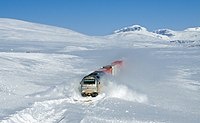
Photo from wikipedia
The dynamics of nonstructural carbohydrates (NSC) profoundly affect productivity and ecological adaptability to adversity in plants. Global warming induced the frequent occurrence of extreme precipitation events that altered the winter… Click to show full abstract
The dynamics of nonstructural carbohydrates (NSC) profoundly affect productivity and ecological adaptability to adversity in plants. Global warming induced the frequent occurrence of extreme precipitation events that altered the winter snow pattern in deserts. However, there is a lack of understanding of how desert mosses respond to long-term snow cover change at the NSC level. Therefore, in this study, long-term (7-years) winter snow removal (-S), ambient snow (CK), and double snow (+S) experiments were set in the field to investigate the content of NSC and its component in Syntrichia Caninervis. Our results showed that changes in snow depth, snow years, and their interaction significantly affected NSC and its component of Syntrichia caninervis. Compared to snow removal, NSC, soluble sugar, and starch significantly decreased with the increasing snow depth. The ratio of soluble sugar to starch significantly increased, while NSC and soluble sugar gradually returned to the normal level with an increase in snow years. It is worth mentioning that snow removal significantly reduced the soluble sugar to starch ratio compared to ambient snow depth, whereas the double snow experiment significantly increased the ratio of soluble sugar to starch during winter. This indicated an obvious trade-off between carbon utilization and carbon storage in Syntrichia caninervis. Snow removal stimulated Syntrichia caninervis to store sufficient carbon sources by starch accumulation for its future growth, while double snow promoted its current growth by soluble sugar accumulation. The variance in decomposition showed that soil physical and chemical properties, snow cover, and their interaction explained 83% of the variation in NSC and its components, with soil and plant water content, pH, and electrical conductivity (P-WC, S-WC, S-pH, and S-EC) as significant predictors. This highlights that snow indirectly affected NSC and its component contents by changing soil physical and chemical properties; however, long-term changes in snow cover could slow down its sensitivity to snow.
Journal Title: Frontiers in Plant Science
Year Published: 2022
Link to full text (if available)
Share on Social Media: Sign Up to like & get
recommendations!